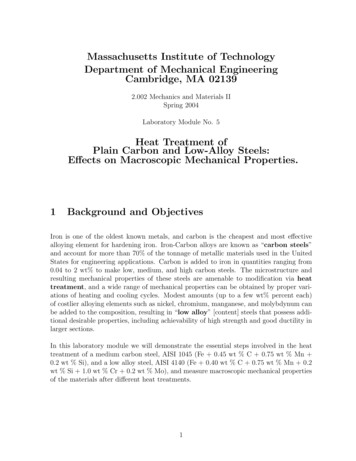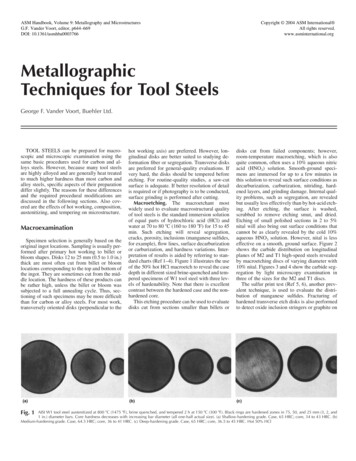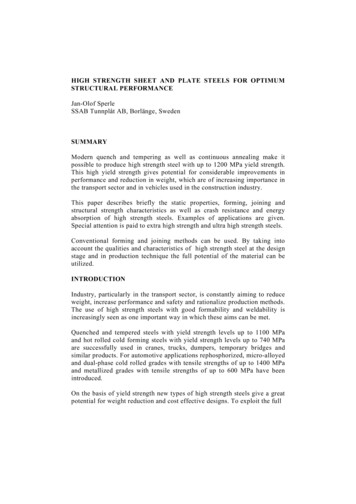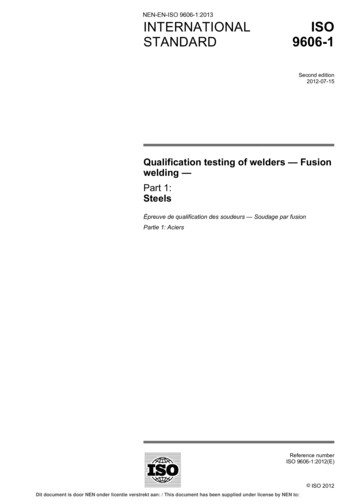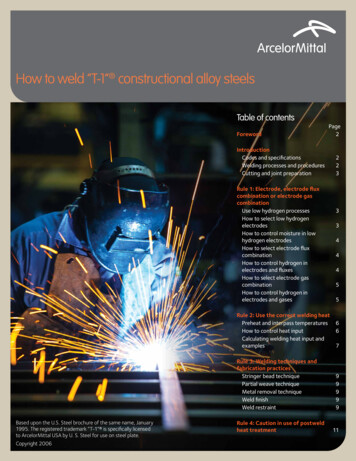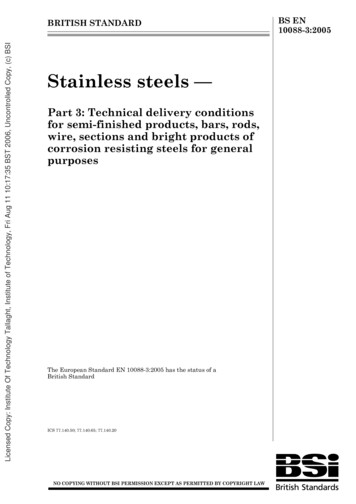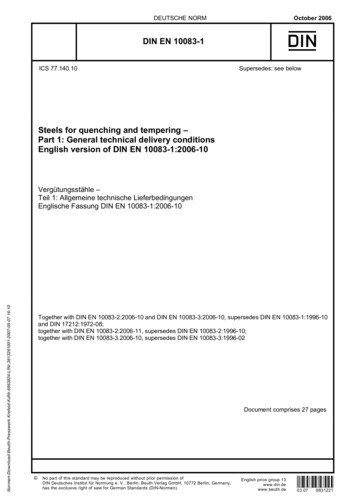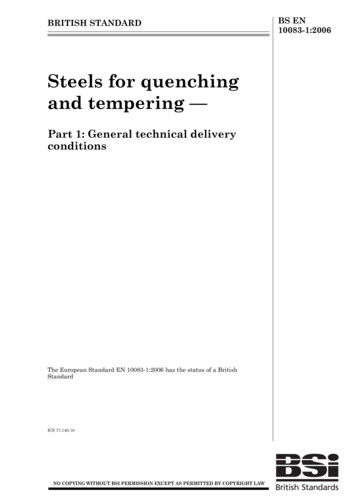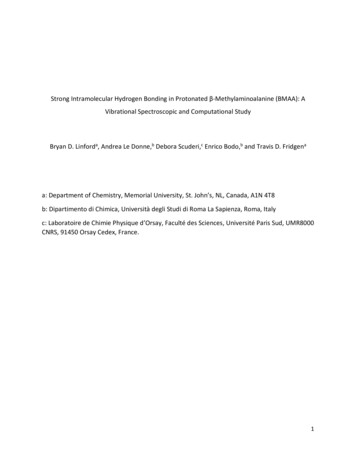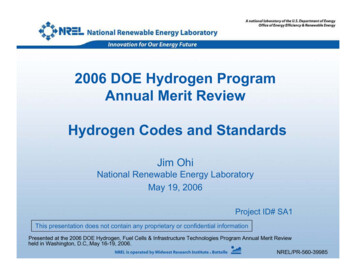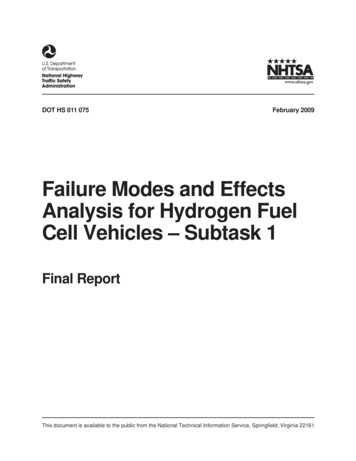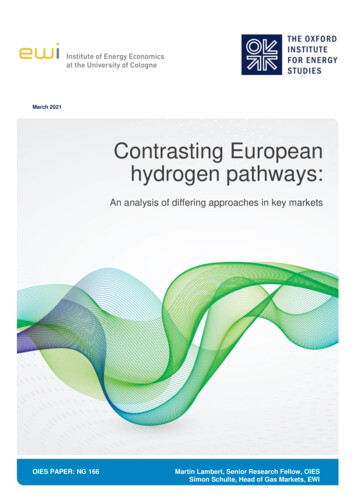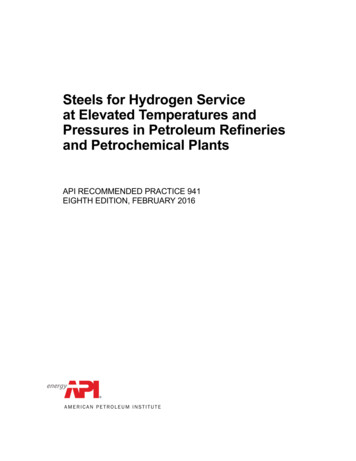
Transcription
Steels for Hydrogen Serviceat Elevated Temperatures andPressures in Petroleum Refineriesand Petrochemical PlantsAPI RECOMMENDED PRACTICE 941EIGHTH EDITION, FEBRUARY 2016
Special NotesAPI publications necessarily address problems of a general nature. With respect to particular circumstances, local,state, and federal laws and regulations should be reviewed.Neither API nor any of API's employees, subcontractors, consultants, committees, or other assignees make anywarranty or representation, either express or implied, with respect to the accuracy, completeness, or usefulness of theinformation contained herein, or assume any liability or responsibility for any use, or the results of such use, of anyinformation or process disclosed in this publication. Neither API nor any of API's employees, subcontractors,consultants, or other assignees represent that use of this publication would not infringe upon privately owned rights.API publications may be used by anyone desiring to do so. Every effort has been made by the Institute to assure theaccuracy and reliability of the data contained in them; however, the Institute makes no representation, warranty, orguarantee in connection with this publication and hereby expressly disclaims any liability or responsibility for loss ordamage resulting from its use or for the violation of any authorities having jurisdiction with which this publication mayconflict.API publications are published to facilitate the broad availability of proven, sound engineering and operatingpractices. These publications are not intended to obviate the need for applying sound engineering judgmentregarding when and where these publications should be utilized. The formulation and publication of API publicationsis not intended in any way to inhibit anyone from using any other practices.Any manufacturer marking equipment or materials in conformance with the marking requirements of an API standardis solely responsible for complying with all the applicable requirements of that standard. API does not represent,warrant, or guarantee that such products do in fact conform to the applicable API standard.Classified areas may vary depending on the location, conditions, equipment, and substances involved in any givensituation. Users of this Recommended Practice should consult with the appropriate authorities having jurisdiction.Users of this Recommended Practice should not rely exclusively on the information contained in this document.Sound business, scientific, engineering, and safety judgment should be used in employing the information containedherein.API is not undertaking to meet the duties of employers, manufacturers, or suppliers to warn and properly train andequip their employees, and others exposed, concerning health and safety risks and precautions, nor undertaking theirobligations to comply with authorities having jurisdiction.Information concerning safety and health risks and proper precautions with respect to particular materials andconditions should be obtained from the employer, the manufacturer or supplier of that material, or the material safetydata sheet.Where applicable, authorities having jurisdiction should be consulted.Work sites and equipment operations may differ. Users are solely responsible for assessing their specific equipmentand premises in determining the appropriateness of applying the Recommended Practice. At all times users shouldemploy sound business, scientific, engineering, and judgment safety when using this Recommended Practice.All rights reserved. No part of this work may be reproduced, translated, stored in a retrieval system, or transmitted by any means,electronic, mechanical, photocopying, recording, or otherwise, without prior written permission from the publisher. Contact thePublisher, API Publishing Services, 1220 L Street, NW, Washington, DC 20005.Copyright 2016 American Petroleum Institute
ForewordNothing contained in any API publication is to be construed as granting any right, by implication or otherwise, for themanufacture, sale, or use of any method, apparatus, or product covered by letters patent. Neither should anythingcontained in the publication be construed as insuring anyone against liability for infringement of letters patent.Shall: As used in a standard, “shall” denotes a minimum requirement in order to conform to the specification.Should: As used in a standard, “should” denotes a recommendation or that which is advised but not required in orderto conform to the specification.This document was produced under API standardization procedures that ensure appropriate notification andparticipation in the developmental process and is designated as an API standard. Questions concerning theinterpretation of the content of this publication or comments and questions concerning the procedures under whichthis publication was developed should be directed in writing to the Director of Standards, American PetroleumInstitute, 1220 L Street, NW, Washington, DC 20005. Requests for permission to reproduce or translate all or any partof the material published herein should also be addressed to the director.Generally, API standards are reviewed and revised, reaffirmed, or withdrawn at least every five years. A one-timeextension of up to two years may be added to this review cycle. Status of the publication can be ascertained from theAPI Standards Department, telephone (202) 682-8000. A catalog of API publications and materials is publishedannually by API, 1220 L Street, NW, Washington, DC 20005.Suggested revisions are invited and should be submitted to the Standards Department, API, 1220 L Street, NW,Washington, DC 20005, standards@api.org.iii
ContentsPage1Scope . . . . . . . . . . . . . . . . . . . . . . . . . . . . . . . . . . . . . . . . . . . . . . . . . . . . . . . . . . . . . . . . . . . . . . . . . . . . . . . . . . 12Normative References . . . . . . . . . . . . . . . . . . . . . . . . . . . . . . . . . . . . . . . . . . . . . . . . . . . . . . . . . . . . . . . . . . . . 133.13.23.33.43.5Operating Experience . . . . . . . . . . . . . . . . . . . . . . . . . . . . . . . . . . . . . . . . . . . . . . . . . . . . . . . . . . . . . . . . . . . . .Basis for Setting Integrity Operating Windows . . . . . . . . . . . . . . . . . . . . . . . . . . . . . . . . . . . . . . . . . . . . . . . .Selecting Materials for New Equipment . . . . . . . . . . . . . . . . . . . . . . . . . . . . . . . . . . . . . . . . . . . . . . . . . . . . . .High Temperature Hydrogen Attack (HTHA) in a Liquid Hydrocarbon Phase . . . . . . . . . . . . . . . . . . . . . . .Base Material for Refractory-lined Equipment or Piping . . . . . . . . . . . . . . . . . . . . . . . . . . . . . . . . . . . . . . . .References and Comments for Figure 1. . . . . . . . . . . . . . . . . . . . . . . . . . . . . . . . . . . . . . . . . . . . . . . . . . . . . .22244444.14.24.3Forms of HTHA . . . . . . . . . . . . . . . . . . . . . . . . . . . . . . . . . . . . . . . . . . . . . . . . . . . . . . . . . . . . . . . . . . . . . . . . . .General . . . . . . . . . . . . . . . . . . . . . . . . . . . . . . . . . . . . . . . . . . . . . . . . . . . . . . . . . . . . . . . . . . . . . . . . . . . . . . . . .Surface Decarburization . . . . . . . . . . . . . . . . . . . . . . . . . . . . . . . . . . . . . . . . . . . . . . . . . . . . . . . . . . . . . . . . . . .Internal Decarburization, Fissuring, and Cracking . . . . . . . . . . . . . . . . . . . . . . . . . . . . . . . . . . . . . . . . . . . . .778855.15.25.35.45.5Factors Influencing Internal Decarburization, Fissuring, and Cracking Caused by HTHA . . . . . . . . . . . . 9Incubation Time . . . . . . . . . . . . . . . . . . . . . . . . . . . . . . . . . . . . . . . . . . . . . . . . . . . . . . . . . . . . . . . . . . . . . . . . . . 9Effect of Primary Stresses . . . . . . . . . . . . . . . . . . . . . . . . . . . . . . . . . . . . . . . . . . . . . . . . . . . . . . . . . . . . . . . . 11Effect of Secondary Stresses. . . . . . . . . . . . . . . . . . . . . . . . . . . . . . . . . . . . . . . . . . . . . . . . . . . . . . . . . . . . . . 11Effect of Heat Treatment . . . . . . . . . . . . . . . . . . . . . . . . . . . . . . . . . . . . . . . . . . . . . . . . . . . . . . . . . . . . . . . . . . 11Effect of Stainless Steel Cladding or Weld Overlay . . . . . . . . . . . . . . . . . . . . . . . . . . . . . . . . . . . . . . . . . . . 1266.16.2Inspection for HTHA . . . . . . . . . . . . . . . . . . . . . . . . . . . . . . . . . . . . . . . . . . . . . . . . . . . . . . . . . . . . . . . . . . . . . 13General . . . . . . . . . . . . . . . . . . . . . . . . . . . . . . . . . . . . . . . . . . . . . . . . . . . . . . . . . . . . . . . . . . . . . . . . . . . . . . . . 13References . . . . . . . . . . . . . . . . . . . . . . . . . . . . . . . . . . . . . . . . . . . . . . . . . . . . . . . . . . . . . . . . . . . . . . . . . . . . . 14Annex A (informative) HTHA of 0.5Mo Steels . . . . . . . . . . . . . . . . . . . . . . . . . . . . . . . . . . . . . . . . . . . . . . . . . . . . . . 15Annex B (informative) HTHA of 1.25 Cr-0.5Mo Steel . . . . . . . . . . . . . . . . . . . . . . . . . . . . . . . . . . . . . . . . . . . . . . . . 25Annex C (informative) HTHA of 2.25Cr-1Mo Steel . . . . . . . . . . . . . . . . . . . . . . . . . . . . . . . . . . . . . . . . . . . . . . . . . . 27Annex D (informative) Effective Pressures of Hydrogen in Steel Covered by Clad/Overlay . . . . . . . . . . . . . . . 29Annex E (informative) Summary of Inspection Methods. . . . . . . . . . . . . . . . . . . . . . . . . . . . . . . . . . . . . . . . . . . . . 30Annex F (informative) HTHA of Non-PWHT’d Carbon Steels . . . . . . . . . . . . . . . . . . . . . . . . . . . . . . . . . . . . . . . . . 34Annex G (informative) Methodology for Calculating Hydrogen Partial Pressure in Liquid-filled Piping . . . . . 37Annex H (informative) Internal Company Data Collection—Request for New Information. . . . . . . . . . . . . . . . . 41Bibliography . . . . . . . . . . . . . . . . . . . . . . . . . . . . . . . . . . . . . . . . . . . . . . . . . . . . . . . . . . . . . . . . . . . . . . . . . . . . . . . . 43Figures1Operating Limits for Steels in Hydrogen Service to Avoid High Temperature Hydrogen Attack . . . . . . . 32C-0.5Mo Steel (ASTM A204 Grade A) Showing Internal Decarburization and Fissuring inHigh Temperature Hydrogen Service . . . . . . . . . . . . . . . . . . . . . . . . . . . . . . . . . . . . . . . . . . . . . . . . . . . . . . . . 93Incubation Time for High Temperature Hydrogen Attack Damage of Carbon Steel (Non-weldedor Welded with Postweld Heat Treatment) in High Temperature Hydrogen Service . . . . . . . . . . . . . . . . . 10A.1 Experience with C-0.5Mo and Mn-0.5Mo Steel in High Temperature Hydrogen Service . . . . . . . . . . . . . 16v
ContentsPageA.2 Steels in High Temperature Hydrogen Service Showing Effect of Molybdenum and TraceAlloying Elements . . . . . . . . . . . . . . . . . . . . . . . . . . . . . . . . . . . . . . . . . . . . . . . . . . . . . . . . . . . . . . . . . . . . . . .A.3 Incubation Time for High Temperature Hydrogen Attack Damage of 0.5Mo Steels in HighTemperature Hydrogen Service . . . . . . . . . . . . . . . . . . . . . . . . . . . . . . . . . . . . . . . . . . . . . . . . . . . . . . . . . . . .B.1 Operating Conditions for 1.25Cr-0.5Mo Steels That Experienced High Temperature HydrogenAttack Below the Figure 1 Curve . . . . . . . . . . . . . . . . . . . . . . . . . . . . . . . . . . . . . . . . . . . . . . . . . . . . . . . . . . .C.1 Operating Conditions of 2.25Cr-1Mo Steels That Experienced High Temperature Hydrogen AttackBelow the Figure 1 Curve . . . . . . . . . . . . . . . . . . . . . . . . . . . . . . . . . . . . . . . . . . . . . . . . . . . . . . . . . . . . . . . . .F.1 Operating Conditions for Carbon Steel (Welded with No PWHT) That Experienced HTHA Belowthe 1977 Carbon Steel Figure 1 Curve . . . . . . . . . . . . . . . . . . . . . . . . . . . . . . . . . . . . . . . . . . . . . . . . . . . . . .TablesA.1 Operating Conditions for C-0.5Mo Steels That Experienced High Temperature Hydrogen AttackBelow the 0.5Mo Steel Curve in Figure A.1 . . . . . . . . . . . . . . . . . . . . . . . . . . . . . . . . . . . . . . . . . . . . . . . . . .A.2 References Along with Chromium, Molybdenum, Vanadium and Molybdenum EquivalentValues for Figure A.2. . . . . . . . . . . . . . . . . . . . . . . . . . . . . . . . . . . . . . . . . . . . . . . . . . . . . . . . . . . . . . . . . . . . .B.1 Experience with HTHA of 1.25Cr-0.5Mo Steel at Operating Conditions Below the Figure 1 Curve. . . . .C.1 Experience with High Temperature Hydrogen Attack of 2.25Cr-1Mo Steel at OperatingConditions Below the Figure 1 Curve . . . . . . . . . . . . . . . . . . . . . . . . . . . . . . . . . . . . . . . . . . . . . . . . . . . . . . .E.1 Summary of Ultrasonic Inspection Methods for High Temperature Hydrogen Attack . . . . . . . . . . . . . . .E.2 Summary of Non-ultrasonic Inspection Methods for High Temperature Hydrogen Attack . . . . . . . . . . .G.1 Effective Hydrogen Partial Pressures . . . . . . . . . . . . . . . . . . . . . . . . . . . . . . . . . . . . . . . . . . . . . . . . . . . . . . .G.2 Effective Hydrogen Partial Pressures with the Composition Variation Compensation Method. . . . . .vi22232628352124252731333940
IntroductionAt normal atmospheric temperatures, gaseous molecular hydrogen does not readily permeate steel, even at highpressures. Carbon steel is the standard material for cylinders that are used to transport hydrogen at pressures of2000 psi (14 MPa). Many postweld heat treated carbon steel pressure vessels have been used successfully incontinuous service at pressures up to 10,000 psi (69 MPa) and temperatures up to 430 F (221 C). However, underthese same conditions, highly stressed carbon steels and hardened steels have cracked due to hydrogenembrittlement.The recommended maximum hydrogen partia
Generally, API standards are reviewed and revised, reaffirmed, or withdrawn at least every five years. A one-time extension of up to two years may be added to this review cycle. Status of the publication can be ascertained from the API Standards Department, telephone (202) 682-8000. A catalog of API publications and materials is published annually by API, 1220 L Street, NW, Washington, DC .
